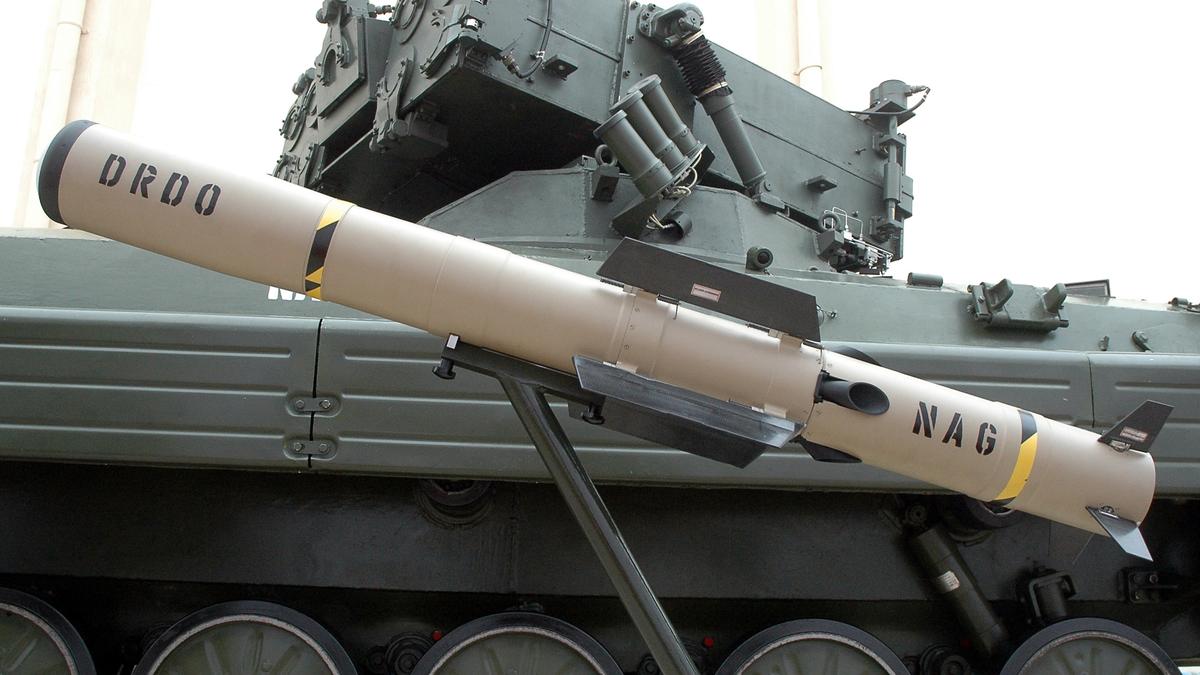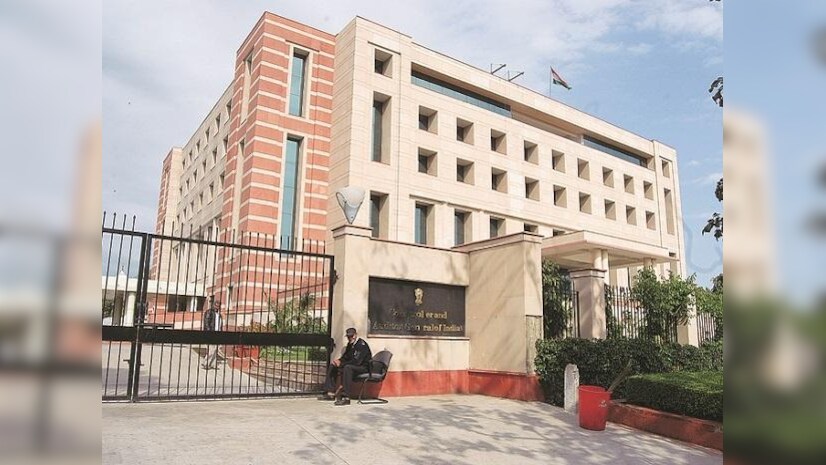Nag Anti-Tank Missile System (NAMIS)

- 31 Mar 2025
In News:
The Ministry of Defence (MoD) signed contracts worth approximately ?2,500 crore for procuring advanced anti-tank missile systems and light vehicles to enhance the Indian Army's operational capabilities.
Nag Anti-Tank Missile System (NAMIS)
- Development and Production:Developed by the Defence Research and Development Laboratory (DRDL) under the Defence Research and Development Organisation (DRDO) and produced by Bharat Dynamics Limited (BDL).
- System Overview:NAMIS is a tracked, third-generation anti-tank guided missile (ATGM) system mounted on a BMP-2 chassis (Nag Missile Carrier or NAMICA). It features a ‘fire-and-forget’ capability, employing an Imaging Infrared (IIR) seeker to lock on to heavily armored targets before launch.
- Key Features:
- Range: 500 meters to 4 kilometers.
- Attack Modes:
- Top Attack Mode: Missile climbs and strikes the target from above to penetrate weaker top armor.
- Direct Attack Mode: Missile flies directly to strike the target.
- Night Capability: Operates effectively under low visibility.
- Mobility: Based on the amphibious BMP-2, NAMIS can operate across varied terrains.
- Significance:The tracked NAMIS enhances the anti-tank capabilities of mechanized infantry, marking a crucial step in modernizing the Indian Army’s battlefield readiness.
- Other Nag Variants:The Helina is a helicopter-launched version designed for deployment on Rudra and Light Combat Helicopters (LCH), successfully tested in 2018.
Light Vehicles Procurement
- The MoD signed contracts with Force Motors Limited and Mahindra & Mahindra Limited for around 5,000 light vehicles.
- These vehicles are equipped with enhanced engine power and designed to carry payloads of up to 800 kg, ensuring mobility across diverse terrains and operational conditions.
Additional Defence Contract
- Zen Technologies Limited secured a contract worth approximately ?152 crore for supplying Integrated Air Defence Combat Simulators (IADCS) for the Army’s L70 air defence guns.
- The IADCS is a virtual training system developed under the Make-II category to provide realistic simulation-based training for air defence operations.
CAG and BISAG-N collaborate to enhance auditing through advanced Geo-spatial Technologies

- 31 Mar 2025
In News:
The Comptroller and Auditor General (CAG) of India has entered into a significant partnership with the Bhaskaracharya National Institute for Space Applications and Geo-informatics (BISAG-N) to leverage advanced technologies in geographic information systems (GIS), remote sensing, and satellite image analytics for strengthening audit processes.
About BISAG-N
- Institution Profile: BISAG-N is an autonomous scientific society under the Ministry of Electronics & Information Technology (MeitY), Government of India, located in Gandhinagar, Gujarat. It operates under the Societies Registration Act, 1860.
- Core Domains: The institute specializes in satellite communication, geo-informatics, and geo-spatial technologies.
- Functions: BISAG-N develops and manages GIS databases, creates and updates maps, conducts data migration and format translation, provides software customization and systems integration, and offers technical consulting for large-scale GIS implementations.
- Applications: It delivers comprehensive geo-spatial solutions including photogrammetry, cartography, remote sensing applications for agriculture (crop monitoring), watershed management, forest fire mapping, and environmental resource management.
- Collaborations: BISAG-N works closely with central ministries and state government agencies to support planning and development activities using space and geo-spatial technologies.
Details of the CAG-BISAG-N Partnership
- Objective: The partnership aims to integrate cutting-edge geo-spatial tools such as Artificial Intelligence (AI), Machine Learning (ML), and Big Data Analytics into the CAG's audit methodologies. This will enhance audit accuracy, efficiency, and accountability.
- Key Focus Areas:
- Developing customized geo-spatial solutions and platforms for audit analysis.
- Utilizing data available from government initiatives like PM GatiShakti for comprehensive audit evaluations.
- Conducting joint research in geo-spatial analysis, remote sensing, and satellite image analytics.
- Organizing training and capacity-building programs to equip CAG officials with skills in geo-spatial technologies.
- Significance: This collaboration reflects the CAG’s commitment to adopting digital public infrastructure and technological innovation, enhancing governance, and reinforcing financial accountability in India’s public institutions.
Gaia Space Observatory
- 31 Mar 2025
In News:
The European Space Agency (ESA) has officially retired its Gaia space observatory after over nine years of pioneering work in astrometry. Launched in December 2013, Gaia was designed to create the most detailed three-dimensional map of the Milky Way galaxy, transforming our understanding of its structure, evolution, and constituents.
About Gaia
- Mission Objective: Gaia aimed to precisely measure the positions, distances, motions, and physical properties of over 2 billion stars within the Milky Way. Its data helps scientists study the galaxy’s formation, predict its future evolution, and explore celestial phenomena.
- Orbit & Technology: Stationed at the second Lagrange point (L2), about 1.5 million kilometers from Earth, Gaia operated beyond the disturbances of Earth’s atmosphere, sun, and moon. Equipped with twin telescopes focusing light onto a nearly one-billion-pixel digital camera—the largest ever deployed in space—the observatory had three key instruments: an astrometer, photometer, and spectrometer to measure stellar positions, brightness, and compositions.
Major Contributions and Discoveries
- 3D Galactic Map: Gaia revealed the warped and wobbling nature of the Milky Way’s disc, mapped its spiral arms and central bulge, and detailed its dynamic evolution shaped by ancient galactic collisions. These findings shed light on events influencing the formation of stars including our Sun.
- New Black Holes: The mission identified previously unseen black holes detectable only by their gravitational influence, marking a first in astronomical observations.
- Asteroid Cataloguing: Gaia tracked the paths of over 150,000 asteroids, enabling better prediction of their trajectories and potential threats to Earth.
- Legacy and Data: Although Gaia has mapped approximately 2% of the galaxy’s stars so far, its extensive data sets continue to be processed and released, promising decades of future scientific breakthroughs.
End of Mission and Legacy
In March 2025, ESA safely deactivated Gaia by draining its energy and shifting it to a retirement orbit around the Sun, ensuring it does not interfere with upcoming missions. While the spacecraft’s active observations have ended, Gaia’s rich data legacy remains invaluable to astronomers worldwide.
Sahkar Taxi

- 31 Mar 2025
In News:
The government has announced the upcoming introduction of ‘Sahkar Taxi’, a cooperative-based ride-hailing platform designed to directly benefit drivers by eliminating intermediary commissions.
What is ‘Sahkar Taxi’?
‘Sahkar Taxi’ is a ride-hailing service supported by the government, operated through cooperative societies. Unlike conventional app-based services such as Ola and Uber, this platform allows drivers to retain their full earnings, without deductions by middlemen or aggregators. It draws inspiration from existing app-based models but is fundamentally driven by cooperative principles.
Why is ‘Sahkar Taxi’ Needed?
- Concerns Over Commission Charges: Leading ride-hailing apps have faced criticism for imposing high commission fees, reducing the take-home earnings of drivers.
- Pricing Transparency Issues: Allegations of differential pricing based on the type of user device (e.g., iPhone versus Android) have sparked doubts regarding fairness and transparency.
- Driver Challenges: Centralized control by large platforms often leaves drivers with limited negotiation power and inadequate income security.
Importance and Impact of ‘Sahkar Taxi’
- Driver Empowerment: By establishing a cooperative ownership model, drivers gain a stronger stake in the business, leading to improved financial stability.
- Decentralized Economic Participation: The initiative encourages local involvement and collective growth, aligning with the government’s vision of ‘Sahkar Se Samriddhi’ (Prosperity through Cooperation).
- Sustainable Alternative: It presents a viable, inclusive option to the dominant profit-driven ride aggregator market, focusing on equitable benefit sharing.
- Enhanced Consumer Confidence: The cooperative framework promotes transparent pricing and greater accountability in digital service delivery, fostering trust among users.
National Technical Textiles Mission
- 31 Mar 2025
In News:
India’s textile sector plays a vital role in the country’s economy, contributing nearly 2% to GDP and ranking as the world’s 6th largest textile exporter with a 3.9% share of global textile exports. The sector is projected to grow to USD 350 billion by 2030, generating around 3.5 crore jobs. Alongside traditional textiles, technical textiles—specialized fabrics designed for specific industrial and functional uses—are emerging as a major growth driver.
What are Technical Textiles?
Technical textiles are fabrics engineered for performance rather than aesthetics. They serve diverse sectors such as agriculture, healthcare, construction, automotive, and safety by providing solutions like protective gear, medical textiles, geotextiles, and industrial fabrics. The industry segments technical textiles into 12 categories based on application.
National Technical Textiles Mission (NTTM)
To capitalize on this potential, the Ministry of Textiles launched the National Technical Textiles Mission (NTTM) in 2020, with an outlay of ?1,480 crore running through 2025-26. The mission aims to position India as a global leader in technical textiles by focusing on innovation, research, market expansion, export promotion, and skill development.
Four Pillars of NTTM:
- Research, Innovation, and Development: Funding and supporting R&D projects to develop new materials and processes.
- Promotion and Market Development: Facilitating wider adoption of technical textiles domestically and internationally.
- Export Promotion: Establishing dedicated export councils to enhance global market access.
- Education, Training, and Skill Development: Training 50,000 individuals, from students to professionals, through specialized courses and industry internships.
Since its inception, NTTM has approved 168 research projects worth ?509 crore and allocated ?517 crore towards mission activities. So far, ?393.39 crore has been utilized for research, market promotion, export, and skill training.
Key Initiatives under NTTM
- GIST 2.0 (Grant for Internship Support in Technical Textiles): Bridges academia and industry by providing hands-on learning and internships, fostering innovation and supporting the Make in India initiative.
- GREAT Scheme (Grant for Research & Entrepreneurship across Aspiring Innovators in Technical Textiles): Funds startups and educational institutions to commercialize innovative technical textile products. For example, 8 startups received ?50 lakh each to develop medical, industrial, and protective textiles. IIT Indore and NIT Patna were awarded ?6.5 crore to launch specialized courses in geotextiles and sports textiles.
- Skill Development: Courses developed by premier textile research associations like SITRA, NITRA, and SASMIRA train workers in sectors such as medical, protective, mobile, and agricultural textiles.
- Technotex 2024: A platform showcasing cutting-edge projects under the NTTM Innovation Zone, featuring 71 innovations to attract global investments.
Impact and Success Stories
India is witnessing rapid innovation in technical textiles. For instance, Eicher Goodearth’s “Mahina” is India’s first bonded leak-proof period underwear, providing 12-hour protection using natural materials and reusable up to 100 washes.
Several states are prioritizing technical textiles growth through policy support. Tamil Nadu’s budget highlights include establishing the PM MITRA Park in Virudhunagar and a textile park in Salem, along with increased subsidies for machinery modernization in spinning units—from 2% to 6%—to lower costs and boost competitiveness.
